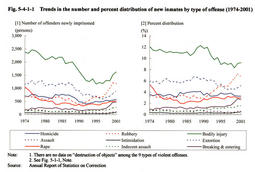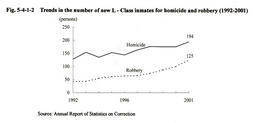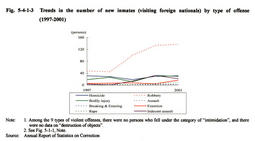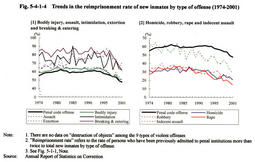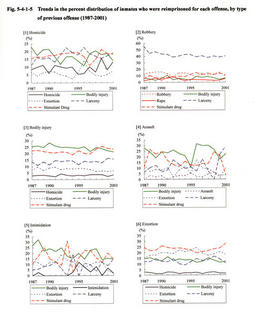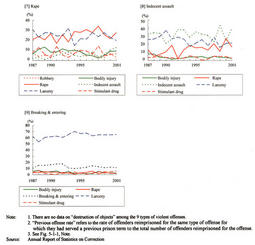| Previous Next Index Image Index Year Selection | |
|
|
1 Trends in correction of adult offenders (1) Overall trend of inmates Fig. 5-4-1-1 shows the trends in the numbers and percent distribution of new inmates for homicide and 9 types of violent offenses by type of offense over the period from 1974 to 2001. The number of new inmates, which had shown an overall decreasing trend, started rising in around 1996. Among the offenses above, bodily injury was greatest in number, followed by robbery, extortion, homicide, rape and breaking and entering, in that order. In particular, robbery has increased noticeably since 1997.
Along with the rise in the number of persons cleared of robbery, in recent years, new inmates sentenced to long-term imprisonment have also increased. The inmates whose imprisonment terms are more than 8 Years are categorized as L-Class inmates, and the majority of L-Class inmates are for homicide and robbery. Fig. 5-4-1-2 shows the trends in the number of new L-Class inmates for these 2 offenses. Regarding homicide, the number of new L-Class inmates, which had continued moderately rising over the last decade reached 128 in 1992 increasing to 194 in 2001. As for robbery, the number of new L-Class inmates, which had increased noticeably since 1998, reached 43 in 1992. In 2001, it reached 125, an increase of 191% (82) in the last 10 years. Fig. 5-4-1-1 Trends in the number and percent distribution of new inmates by type of offense 1974-2001) Fig. 5-4-1-2 Trends in the number of new L-Class inmates for homicide and robbery (1992-2001) Additionally, we will offer an overview of trends in visiting foreign nationals who committed homicide or the 9 types of violent offenses. In penal institutions, foreign nationals who need treatment programs different from those for Japanese inmates are categorized as F-Class inmates. Fig. 5-4-1-3 shows the trends in the number of new inmates who are visiting foreign nationals by type of offence since 1997, when statistics were first prepared for them. Visiting foreign nationals have the largest share of F-Class inmates. By offense, concerning new inmates who are visiting foreign nationals and were imprisoned to penal institutions in 2001, robbery had the largest share, followed by homicide bodily injury, and breaking and entering, in that order. Of these offenses, robbery has remarkably increased, showing a rid upsurge since 1999.Fig. 5-4-1-3 Trends in the number of new inmates (visiting foreign g foreign nationals) by type of offense (2) Trends in the inmates who were reimprisoned to penal institutions Fig. 5-4-1-4 shows the percent distribution of inmates who were reimprisoned (inmates who have been imprisoned to penal institutions more than once) to total new inmates for homicide and the 9 types of violent offenses. According to this information, it can be presumed that the shared percent distribution of inmates who were reimprisoned has been decreasing since around 1996, and instead, the number of new inmates who were imprisoned for the first time has increased, expanding its share.
Compared to total penal code offenses, heinous offenses and sexual offenses, such as homicide, robbery, rape and indecent assault, etc. have low reimprisonment rates. On the other hand, breaking and entering, intimidation, assault, and extortion have high reimprisonment rates. Fig. 5-4-1-5 shows the percent distribution of persons who were reimprisoned for homicide and the 9 types of violent offenses by type of previous offense. The previous offense type of reimprisoned inmates refers to the type of offense for which they have been previously imprisoned to penal institutions. Regarding homicide and 9 types of violent offenses, bodily injury, rape and indecent assault have a high degree of coincidence between offenses for previous imprisonment and those for reimprisonment (the degree that an offense type for previous imprisonment coincides with that for reimprisonment to penal institutions). Therefore, it can be pointed out that persons who have previously committed these 3 offenses are highly likely to repeat offenses of the same kind. Viewed from the affinity between each offence, there seems to exist some affinity between larceny and robbery, larceny and breaking and entering, stimulant drug offense and bodily injury, and stimulant drug offense and homicide, respectively. Fig. 5-4-1-4 Trends in the reimprisonment rate of new inmates by type of offense (1974-2001) Fig. 5-4-1-5 Trends in the percent distribution of inmates who were reimprisoned for each offense, by type of previous offense (1987-2001) |
